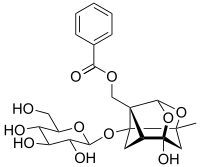 | |
| Names | |
|---|---|
| Other names
Paeonia moutan Paeony root Peoniflorin | |
| Identifiers | |
| CAS Number | |
| 3D model (JSmol) | |
| ChemSpider | |
| ECHA InfoCard | 100.041.327 |
| PubChem CID | |
| UNII | |
| CompTox Dashboard (EPA) | |
InChI
| |
SMILES
| |
| Properties | |
| Chemical formula | C23H28O11 |
| Molar mass | 480.466 g·mol |
| Except where otherwise noted, data are given for materials in their standard state (at 25 °C , 100 kPa). Infobox references | |
Paeoniflorin is a chemical compound which is one of the major constituents of an herbal medicine derived from Paeonia lactiflora. It can also be isolated from the fresh water fern Salvinia molesta.
In Paeonia, it can form new compounds with addition of phenolic substituents. In a study in female rats, paeoniflorin was found to inhibit the production of testosterone within the ovaries, however does not significantly affect the production of Estradiol. In mice, paeoniflorin was shown to protect against neuroinflammation and depression-like behavior induced by IFN alpha.
References
- Yan, D.; Saito, K.; Ohmi, Y.; Fujie, N.; Ohtsuka, K. (2004). "Paeoniflorin, a novel heat shock protein–inducing compound". Cell Stress & Chaperones. 9 (4): 378–89. doi:10.1379/CSC-51R.1. PMC 1065277. PMID 15633296.
- Choudhary, M. I.; Naheed, N.; Abbaskhan, A.; Musharraf, S. G.; Siddiqui, H.; Atta-Ur-Rahman (2008). "Phenolic and other constituents of fresh water fern Salvinia molesta". Phytochemistry. 69 (4): 1018–1023. Bibcode:2008PChem..69.1018C. doi:10.1016/j.phytochem.2007.10.028. PMID 18177906.
- Tanaka, T.; Kataoka, M.; Tsuboi, N.; Kouno, I. (2000). "New monoterpene glycoside esters and phenolic constituents of Paeoniae radix, and increase of water solubility of proanthocyanidins in the presence of paeoniflorin". Chemical & Pharmaceutical Bulletin. 48 (2): 201–207. doi:10.1248/cpb.48.201. PMID 10705504.
- Takeuchi, Toru; Nishii, Osamu; Okamura, Takashi; Yaginuma, Tsutomu (1991). "Effect of Paeoniflorin, Glycyrrhizin and Glycyrrhetic acid on Ovarian Androgen Production". The American Journal of Chinese Medicine. 19 (1): 73–8. doi:10.1142/S0192415X91000119. PMID 1897494.
- Paeoniflorin ameliorates interferon-alpha-induced neuroinflammation and depressive-like behaviors in mice.
This article about an organic compound is a stub. You can help Misplaced Pages by expanding it. |